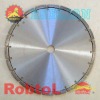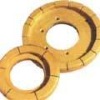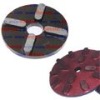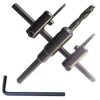Metal injection molding (MIM) is a metalworking process where finely-powdered metal is mixed with a measured amount of binder material to comprise a 'feedstock' capable of being handled by plastic processing equipment through a process known as injection mold forming. The molding process allows complex parts to be shaped in a single operation and in high volume. End products are commonly component items used in various industries and applications. The nature of MIM feedstock flow is defined by a physics called rheology.Current equipment capability requires processing to stay limited to products that can be molded using typical volumes of 100 grams or less per "shot" into the mold. Rheology does allow this "shot" to be distributed into multiple cavities, thus becoming cost-effective for small, intricate, high-volume products which would otherwise be quite expensive to produce by alternate or classic methods. The variety of metals capable of implimentation within MIM feedstock are referred to as powder metallurgy, and these contain the same alloying constiuents found in industry standards for common and exotic metal applications. Subsequent conditioning operations are performed on the molded shape, where the binder material is removed and the metal particles are coalesced into the desired state for the metal alloy.
Process
An early developer of the process during the 1970s was Dr. Raymond E. Wiech Jr., who refined MIM technology as co-founder of a California company named Parmatech; the name being condensed from the phrase 'particle materials technology'. Dr. Wiech later patented[4]his process, and it was widely adopted for manufacturing use in the 1980s. Competing processes included pressed powder sintering, investment casting, and machining. MIM gained recognition throughout the 1990s as improvements to subsequent conditioning processes resulted in an end product that performs similar or better than those made through competing processes. MIM technology improved cost efficiency through high volume production to 'near-net-shape', negated costly, additional operations left unrealized in competing processes, and met rigid dimensional/metalurgical specifications.
The process steps involve combining metal powders with wax and plastic binders to produce the 'feedstock' mix that is injected as a liquid into a hollow mold using plastic injection molding machines. The 'green part' is cooled and de-molded in the plastic molding machine. Next, a portion of the binder material is removed using solvent, thermal furnaces, catalytic process, or a combination of methods. The resulting, fragile and porous (2-4% "air") part, in a condition called "brown" stage, requires the metal to be condensed in a furnace process called Sintering. MIM parts are sintered at temperatures nearly high enough to melt the entire metal part outright (up to 1450 degrees Celsius), at which the metal particle surfaces bind together to result in a final, 96-99% solid density. The end-product MIM metal has comparable mechanical and physical proerties with parts made using classic metalworking methods, and MIM materials are compatible with the same subsequent metal conditioning treatments such as plating, passivating, annealing, carburizing, nitriding, and precipitation hardening.
Applications
The window of economic advantage in metal injection molded parts lies in complexity and volume for small-size parts. MIM materials are comparable to metal formed by competing methods, and final products are used in a broad range of industrial, commercial, medical, dental, firearms, aerospace, and automotive applications. Dimensional tolerances of +/-.003" per linear inch can be commonly held, and far closer restrictions on tolerance are possible with expert knowledge of molding and sintering. MIM can produce parts where it is difficult, or even impossible, to efficiently manufacture an item through other means of fabrication. Increased costs for traditional manufacturing methods inherent to part complexity, such as internal/external threads, miniaturization, or brand identity marking, typically do not increase the cost in a MIM operation due to the flexibility of injection molding.
If you want us to produce your spare parts,pls kindly provide us the following information:
1.2D&3D drawings
2.the materials,surface treatment,and the hardness requirements
3,the quantities you want
4.the usage
5.any other requirements if you have any.












